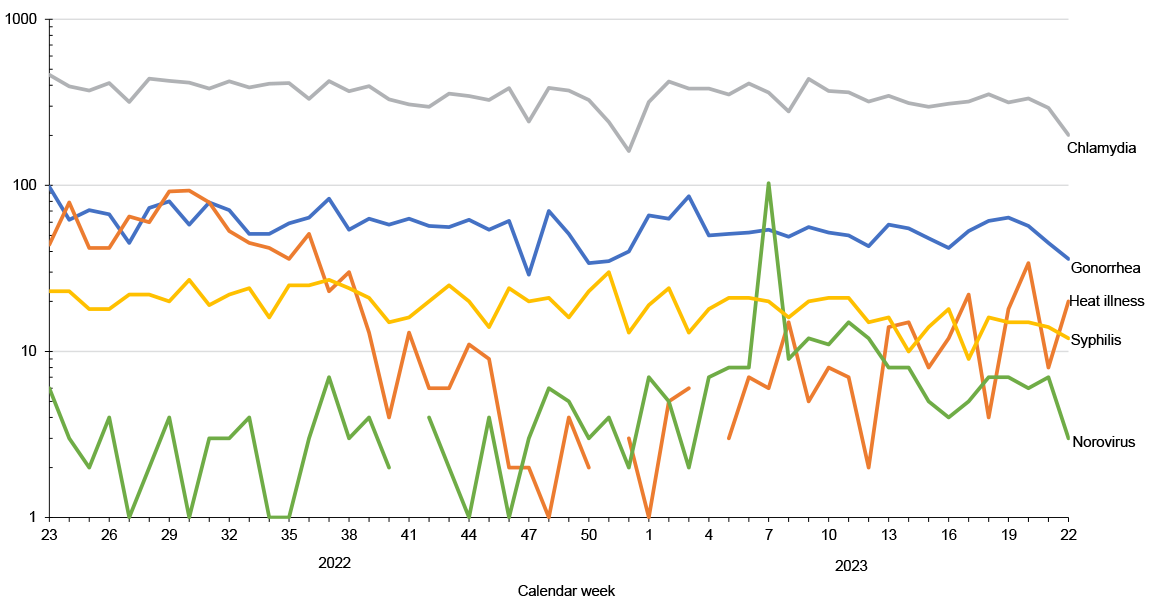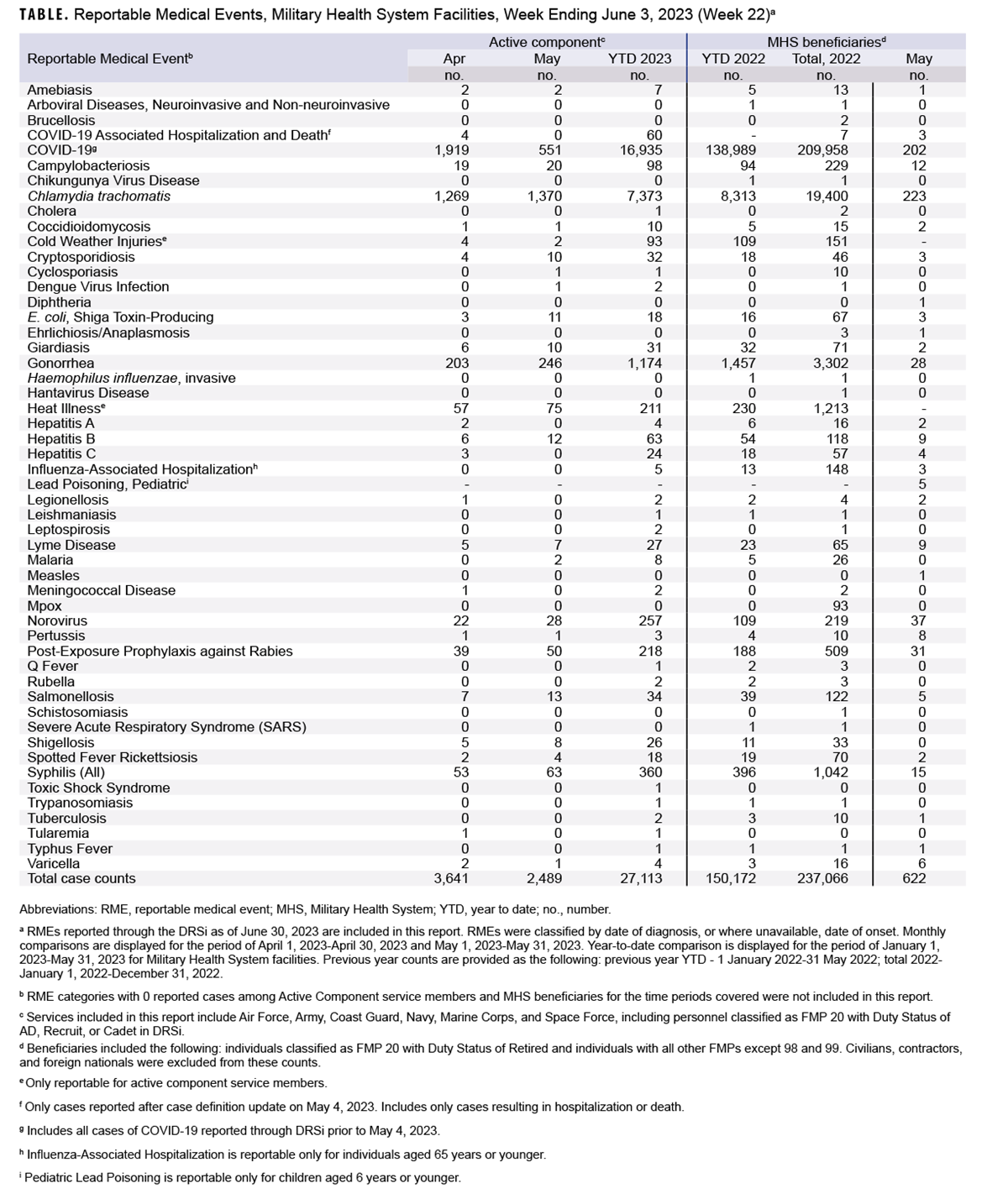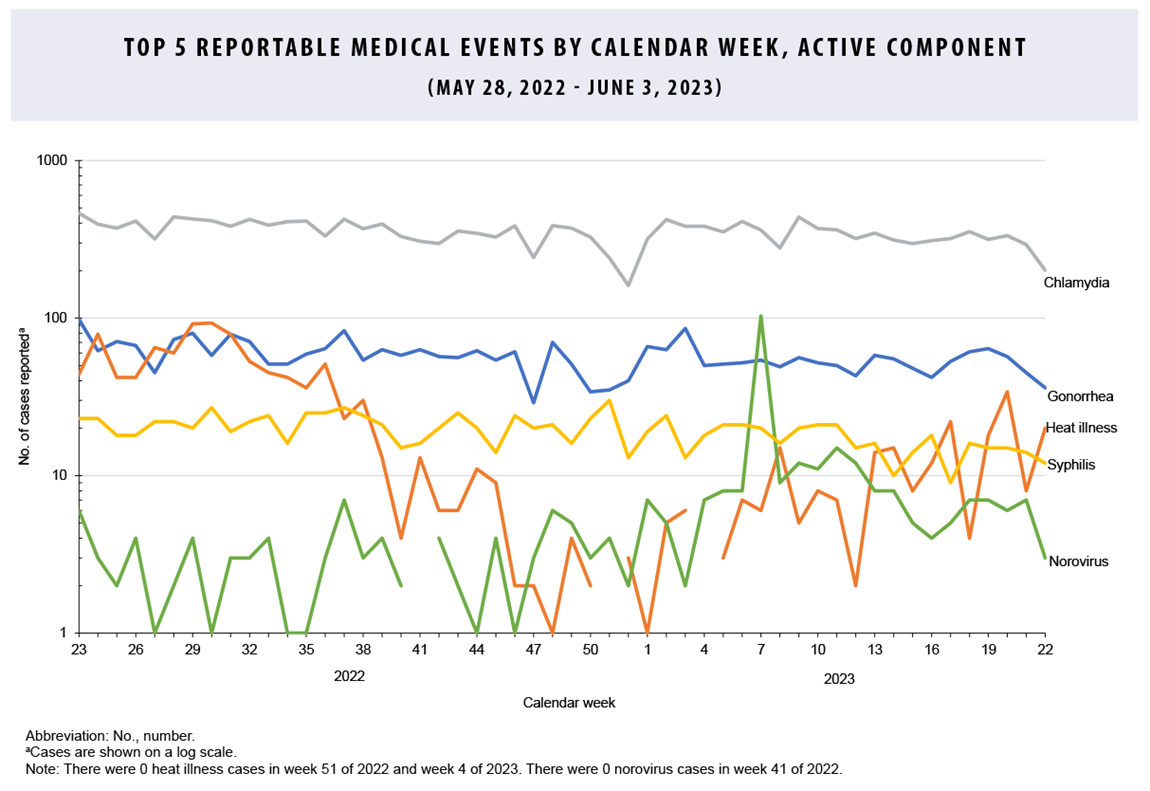Reportable Medical Events, Military Health System Facilities, Week 22, Ending June 3, 2023
 Graph depicting the frequency of the five most common reportable medical events within the Military Health System over the preceding year.
Graph depicting the frequency of the five most common reportable medical events within the Military Health System over the preceding year.
Reportable Medical Events are documented in the Disease Reporting System internet by health care providers and public health officials across the Military Health System for the purpose of monitoring, controlling, and preventing the occurrence and spread of diseases of public health interest or readiness importance. These reports are reviewed by each service’s public health surveillance hub. The DRSi collects reports on over 70 different RMEs, including infectious and non-infectious conditions, outbreak reports, STI risk surveys, and tuberculosis contact investigation reports. A complete list of RMEs is available in the 2022 Armed Forces Reportable Medical Events Guidelines and Case Definitions.1 Data reported in these tables are considered provisional and do not represent conclusive evidence until case reports are fully validated.

Total active component cases reported per week are displayed for the top five RMEs for the previous year. Each month, the graph is updated with the top five RMEs, and is presented with the current month’s (May 2023) top five RMEs, which may differ from previous months. COVID-19 is excluded from these graphs due to changes in reporting/case definition updates in 2023.

References
- Armed Forces Health Surveillance Division. Armed Forces Reportable Medical Events. Accessed April 6, 2023. https://www.health.mil/Military-Health-Topics/Health-Readiness/AFHSD/Reports-and-Publications/Armed-Forces-Reportable-Medical-Events
- Defense Manpower Data Center. Department of Defense Active Duty Military Personnel by Rank/Grade of Service, October 31, 2022. https://dwp.dmdc.osd.mil/dwp/app/dod-data-reports/workforce-reports
- Defense Manpower Data Center. Armed Forces Strength Figures for January 31, 2023. https://dwp.dmdc.osd.mil/dwp/app/dod-data-reports/workforce-reports
- Navy Medicine. Surveillance and Reporting Tools–DRSI: Disease Reporting System Internet. https://www.med.navy.mil/Navy-Marine-Corps-Public-Health-Center/Preventive-Medicine/Program-and-Policy-Support/Disease-Surveillance/DRSI
You also may be interested in...
Photo
Jan 31, 2023
U.S. Navy Hospital Corpsman Dante Horner, a corpsman with 1st Battalion, 8th Marine Regiment, 2d Marine Division, performs tactical combat casualty care during Spanish FLOTEX-22 near Rota, Spain, June 9, 2022. This exercise features tactical level actions ashore, combined with joint training and planning, aimed at increasing overall bilateral ...
Photo
Jun 14, 2022
Aviation Ordnanceman 3rd Class Dominique Campbell drives a forklift on the flight deck of the Nimitz-class aircraft carrier USS Harry S. Truman (CVN 75) during a vertical replenishment. She is wearing proper hearing and vision protection.
Photo
May 12, 2022
U.S. Marines and U.S. Navy Corpsmen with 1st Marine Division asses the injuries under the supervision of evaluators during an Expeditionary Medical Integration Course (EMIC) on Camp Pendleton, California May 5, 2022.
Photo
May 12, 2022
U.S. Army Sgt. 1st Class Mathew Maxwell (Left) and U.S. Capt. Brian Ahern, medical personnel assigned to a Defense POW/MIA Accounting Agency recovery team, check the pulse of a local villager during excavation operations in the Houaphan province, Laos, Feb. 5, 2019. (Photo by Staff Sgt. Michael O'Neal)
Photo
Dec 14, 2021
Hearing loss in the Department of Defense continues to decrease for service members and civilians enrolled in hearing conservation programs.
Photo
Oct 18, 2021
Today’s female service member population is now at 17%.
Photo
Sep 28, 2016
U.S. Air Force Senior Airman Michael Triana, left, 347th Operations Support Squadron independent duty medical technician-paramedic, addresses injuries on a simulated patient during a tactical combat casualty care course, in Okeechobee, Florida. The course tests and reinforces participants’ lifesaving medical skills while they are in high-stress, ...
Photo
Sep 26, 2016
Japan Ground Self-Defense Force medics carry a casualty from an ambulance to a JGSDF helicopter while a U.S. Army medic calls directions during a bilateral medical training exercise.
Photo
Sep 23, 2016
Soldiers from the 7th Mission Support Command, Medical Support Unit-Europe conduct medical evacuation training with Staff Sgt. Jessie Turner, flight medic with the 1st Armored Division's Combat Aviation Brigade. (U.S. Army photo by Sgt. 1st Class Matthew Chlosta)
Photo
Sep 23, 2016
It is important for Soldiers to know what to expect when a MEDEVAC helicopter arrives and how to approach the helicopters, load patients aboard and how to interact with their crew chief and flight medic in order to do ground handoffs. (U.S. Army photo by Sgt. 1st Class Matthew Chlosta)
Photo
Sep 20, 2016
A Ukrainian Soldier uses hand signals during a ground guide exercise of field litter ambulance familiarization on the driving range at Yavoriv Training Area, Ukraine. A team of medics and a mechanic from 557th Medical Company and 212th Combat Support Hospital are working together to conduct field littler ambulance and medical equipment ...
Photo
Sep 20, 2016
Navy Lt. Cmdr. Reginaldo Cagampan, left, and Navy Hospital Corpsman 1st Class Rocky Pambid, members of the U.S. Naval Hospital Yokosuka Emergency Response Team, treat a simulated patient during the 2016 Big Rescue Kanagawa Disaster Prevention Joint Drill in Yokosuka city, Japan. Multiple agencies took part in the drill including the U.S. Navy, Army ...
Photo
Jan 29, 2016
U.S. Government Global Health Security Agenda Partners
You are leaving Health.mil
The appearance of hyperlinks does not constitute endorsement by the Department of Defense of non-U.S. Government sites or the information, products, or services contained therein. Although the Defense Health Agency may or may not use these sites as additional distribution channels for Department of Defense information, it does not exercise editorial control over all of the information that you may find at these locations. Such links are provided consistent with the stated purpose of this website.
You are leaving Health.mil
View the external links disclaimer.
Last Updated: August 24, 2023